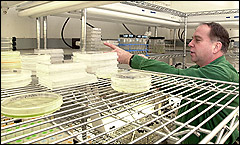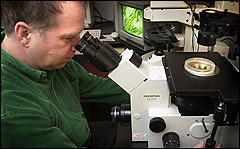Thursday, January 30, 2003
Tree of Life
By MEREDITH GOAD, Portland Press Herald Writer
Copyright © 2003 Blethen Maine Newspapers Inc.
WEST BOOTHBAY HARBOR — There have been many big science projects
in recent years, from the massive effort to decode the human genome
to the launch of probes to Mars. But as big science projects go,
the one that Charles O'Kelly is working on is a doozy.
O'Kelly, a senior research scientist at the Bigelow Laboratory
for Ocean Sciences, is among a group of scientists across the country
who are trying to reconstruct the "Tree of Life," the
framework of animals, plants and microorganisms that illustrates
the evolutionary history and diversity of life on Earth.
The $10 million "Assembling the Tree of Life" project
will help to explain the relationships between the 1.75 million
known species on the planet, revealing their similarities and differences.
It may also have many practical uses, from the discovery of new
medicines to the preservation of biodiversity.
The concept of a Tree of Life is "a big one that has been
occupying intellectual thought for millennia," O'Kelly said.
"It goes all the way back to Aristotle, who basically talked
about the chain of being, the idea that there was some kind of a
hierarchy in life."
The idea caught fire when Charles Darwin used tree imagery to describe
the connectedness of life "with its everbranching and beautiful
ramifications."
But never before have such advanced technological tools been available
for actually assembling the tree.
Scientists involved with the project will use a combination of
genetic data, computer modeling and morphology – information
on the form and structure of a species – to figure out where
the animals or plants they study fit into life's genealogy. They'll
also be developing the molecular, morphological and computational
tools that will be needed to push progress on the tree forward.
"We're trying to speed up how we put this together,"
said Diana Lipscomb, program director for the project at the National
Science Foundation in Washington, D.C.
O'Kelly is part of a research group that is examining 50 of the
green plants, from algae to flowers. The Bigelow researcher will
be responsible for all of the work on green algae.
The green plant project is one of seven funded in October by the
National Science Foundation, and includes scientists from Yale,
Southern Illinois University, Utah State, the University of California-Berkeley,
and the University of Washington. Collectively, they received just
under $3 million.
The other six projects are studying spiders, bacterial DNA, fungi,
parasitic roundworms, birds and dinosaurs.
The scientists who received the grants are expected to set up a
framework for the branch of life they are working on that allows
other researchers to work with it right away.
"Every part of the tree is going to become of interest to
us, either intellectually or practically," O'Kelly said, "and
the goal here is to make sure that we've got the tools so that when
we have that interest we can go at it and we don't have to reinvent
the wheel in order to do it. We can deal with it, and quickly."
The researchers are also supposed to set up systems to disseminate
information about their branch of the tree so that it's readily
available to students, teachers and anyone else who wants access
to it, Lipscomb said.
Putting together those big branches will be no easy task. As many
as 20,000 species of green algae alone have been identified, and
whether or not it's a species often depends on "who's counting
and how they're counting," O'Kelly said.
"We're in a situation where, if you have lions and tigers
and bears, you know what a species is," he said. "If you
have amoebae and flagellates and green algae, you don't know what
a species is, and we are going to need to assemble data such as
we're assembling here before we're going to be able to answer that
question."
One form of algae that O'Kelly is working on right now, for example,
sometimes puts out a little hair that helps it to take in nutrients.
Algae that produce hairs were once thought to be fundamentally different
from those that don't – and therefore in a different place
on the tree of life.
"We're finding that's not important," O'Kelly said. "If
it doesn't make hairs, it just doesn't make hairs. It can still
be in the same group, still be on the same part of the tree of life."
That raises a big question: So what?
"Assembling the Tree of Life" is not just an expensive
intellectual exercise. Information from the tree of life is used
for all kinds of practical purposes, from "bioprospecting"
for new drugs and agricultural products to tracking the origin and
outcome of emerging diseases.
When it was discovered that yew trees in the Pacific Northwest
contain substances powerful for combatting ovarian cancer, Lipscomb
noted, scientists began looking at other types of yew trees to determine
whether they produced the same kinds of chemicals.
"When (West Nile virus) first started showing up, killing
birds and infecting people, people's first question was well, what
is it?" Lipscomb said. "Where did it come from? And that
required someone to go and look at it and figure out where it fit
on this phylogenetic tree. Once they knew that, and they realized
it came from the Old World, they knew exactly what they were dealing
with and how to combat it."
O'Kelly said that even the algae he's working on could prove beneficial.
They contribute to the productivity of the oceans and act as carbon
sinks that can fight global warming. Each species interacts with
others, and potentially useful chemicals are a part of those interactions.
Recently, O'Kelly and another Bigelow researcher published with
some Japanese colleagues a paper on some new species of algae that
produce omega-3 fatty acids, the substance found in fish oil that
protects against heart disease.
"Here are organisms new to science," O'Kelly said, "and
they make bodacious amounts of these omega-3 fatty acids, which
of course have significance for human health."
Staff Writer Meredith Goad can be contacted at 791-6332 or at: mgoad@pressherald.com

Staff photo by Doug Jones
Charles O'Kelly, a senior research scientist at the Bigelow Laboratory
for Ocean Sciences, returns culture samples of green algae to the
shelves of a controlled environment room at the lab. His work is
part of a $10 million project that will help to explain the relationships
between Earth's 1.75 million known species.

Staff photo by Doug Jones
Charles O'Kelly focuses his microscope on a culture of green algae
from a lagoon in the south of France while the image appears on
the screen behind him and a computer program that will help him
compare the sample with Pacific and Atlantic green algae in the
Tree of Life Project.
|





